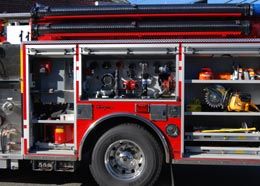| Editor’s note: Has your department come up with an in-house solution for equipment mounts? Have you had a near-miss involving loose equipment in the cab? Share your experiences in the FireRescue1 Forums |
.
 Photo Bob Vaccaro Combination of peg boards and commercial mounts for this vehicle’s compartments. View compartment slideshow |
One of my biggest pet peeves in fire apparatus design is when a fire department orders a $500,000-plus vehicle and has no plan for properly mounting equipment in the compartments.
I have seen plenty of vehicles that have loose equipment thrown in, with no rhyme or reason. Not only is it sloppy, but dangerous as well. It only takes a little planning to do things properly and does not need to be expensive.
There are several equipment mounting options that are available to the fire service. Most departments when writing their specs include equipment mounting. As the majority of the vehicles are equipped at the local manufacturer’s dealer location, it allows for the apparatus committee to make scheduled visits with their equipment and have it mounted to their exact instructions.
Departments that order all new, loose equipment and tools when the vehicle is ordered can have it shipped to the manufacturer to be installed at the factory. If you can, however, I recommend having it performed at the dealer, so you can have a greater say in the mounting process.
NFPA 1901, as I have mentioned time and time again, also has some standards for equipment mounting:
Cabs
14.1.11.1 All equipment required to be used during and emergency response should be securely fastened.
14.1.11.2 All equipment not required to be used during and emergency response, with the exception of SCBA units, shall not be mounted in a driving or crew area unless it is contained in a fully enclosed and latched compartments capable of containing the contents when a 9 G force is applied in the longitudinal axis of the vehicle or a 3 G force is applied in any other direction, or the equipment is mounted in a bracket that can contain the equipment when the equipment is subjected to those same forces.
15.3 Equipment holders or compartments shall be provided for all tools, equipment, and other items that are on the apparatus.
15.3.2 Equipment holders shall be attached and shall be designed so that the equipment remains in place under all vehicle operating conditions.
15.3.3 All tools and equipment shall be readily accessible.
There are also standards for Powered Equipment Racks, & SCBA Storage, Vertical and Horizontal.
What does this all mean? In essence, make sure you don’t have any tool, radio, handlight, forcible entry tool, etc., that could act like a missile in the cab if there’s an accident. The one thing you don’t want is an injury to one of your firefighters when they are responding caused by loosely mounted tools or other items.
Fittings, nozzles and SCBA spare bottles also have a way of becoming loose and can damage compartment doors or even fall off a vehicle if not secured properly.
If your department cannot afford some of the readily available equipment mounts that exist, maybe someone in your department that is handy can come up with a solution using peg boards, simple wood or even PVC homemade brackets.
Whatever you do, try to design the mount for the tool. A well thought out plan will use all space wisely and will not waste any usable areas. When planning out your compartments, if at all possible try to make them the same from vehicle to vehicle, especially on an Engine. Keep your loose fittings in the left front compartment, nozzles in the left rear, etc. This will help in standardization of operation and training for all of your pump or equipment operators.










